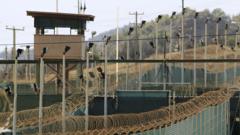The recent transfer signifies a historic low in Guantanamo's population, while negotiations and concerns over detainee treatment continue.
US Transfers 11 Guantanamo Detainees to Oman Amid Ongoing Closure Efforts

US Transfers 11 Guantanamo Detainees to Oman Amid Ongoing Closure Efforts
Yemeni detainees relocated from Guantanamo reflect shifting policies and ongoing legal battles.
The United States has successfully transferred 11 Yemeni detainees from the infamous Guantanamo Bay military prison to Oman, marking a significant milestone in the Biden administration's efforts to reduce the facility's population. With this transfer, only 15 detainees remain at the Cuban site, the lowest count since it was established in 2002.
The Department of Defense expressed gratitude to Oman for its assistance in this endeavor, highlighting the intention to "responsibly reduce the detainee population" and ultimately close the facility. It is noteworthy that none of the detainees transferred had been formally charged with crimes during their lengthy detentions exceeding two decades.
This transfer occurred just days before Khalid Sheikh Mohammed, the alleged mastermind behind the September 11, 2001 attacks, is expected to enter a guilty plea as part of a deal to evade the death penalty. The recent relocation is the largest batch released to a single country under President Joe Biden, emphasizing the administration's commitment to addressing the legacy of Guantanamo.
Despite ongoing complications in Yemen due to civil unrest, the U.S. has deemed Oman a safer option for resettlement, a decision reflective of past attempts to find suitable home countries for the remaining detainees. Among those transferred were individuals like Moath al-Alwi, known for crafting model boats from prison materials, and hunger striker Shaqawi al Hajj, both cleared for release by national security panels.
The historic backdrop of Guantanamo Bay highlights a series of contentious debates regarding detainee treatment and presidential policies, including President Obama’s commitment to close the facility, which faced considerable pushback from Congress. Under Trump, the focus shifted to maintaining the prison, but Biden has reignited efforts to reduce its population in anticipation of closure, though the timeline remains uncertain as the political landscape shifts.
As the military prison, once housing nearly 800 detainees, stands as a reminder of past counter-terrorism strategies, the U.S. grapples with the implications of continued detainment without charges. The recent transfer underscores both a humanitarian effort and a strategic maneuver, as the government navigates complex legal and international waters surrounding the infamous prison's future.
The Department of Defense expressed gratitude to Oman for its assistance in this endeavor, highlighting the intention to "responsibly reduce the detainee population" and ultimately close the facility. It is noteworthy that none of the detainees transferred had been formally charged with crimes during their lengthy detentions exceeding two decades.
This transfer occurred just days before Khalid Sheikh Mohammed, the alleged mastermind behind the September 11, 2001 attacks, is expected to enter a guilty plea as part of a deal to evade the death penalty. The recent relocation is the largest batch released to a single country under President Joe Biden, emphasizing the administration's commitment to addressing the legacy of Guantanamo.
Despite ongoing complications in Yemen due to civil unrest, the U.S. has deemed Oman a safer option for resettlement, a decision reflective of past attempts to find suitable home countries for the remaining detainees. Among those transferred were individuals like Moath al-Alwi, known for crafting model boats from prison materials, and hunger striker Shaqawi al Hajj, both cleared for release by national security panels.
The historic backdrop of Guantanamo Bay highlights a series of contentious debates regarding detainee treatment and presidential policies, including President Obama’s commitment to close the facility, which faced considerable pushback from Congress. Under Trump, the focus shifted to maintaining the prison, but Biden has reignited efforts to reduce its population in anticipation of closure, though the timeline remains uncertain as the political landscape shifts.
As the military prison, once housing nearly 800 detainees, stands as a reminder of past counter-terrorism strategies, the U.S. grapples with the implications of continued detainment without charges. The recent transfer underscores both a humanitarian effort and a strategic maneuver, as the government navigates complex legal and international waters surrounding the infamous prison's future.





















